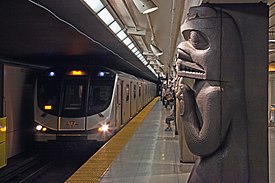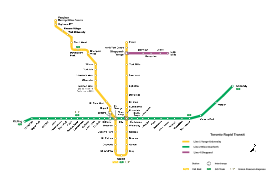Toronto subway
The Toronto subway is a rapid transit system serving Toronto and the neighbouring city of Vaughan in Ontario, Canada, operated by the Toronto Transit Commission (TTC). The subway system is a rail network consisting of three heavy-capacity rail lines operating predominantly underground. As of December 2024,[update] three new lines are under construction: two light rail lines (one running mostly underground, the other running mostly at-grade) and one heavy rail line (running both underground and on elevated guideways).
In 1954, the TTC opened Canada's first underground rail line, then known as the "Yonge subway", under Yonge Street between Union Station and Eglinton Avenue with 12 stations. As of 2024, the network encompasses 70 stations and 70.1 kilometres (43.6 mi) of route.[1][2] In 2023, the system had a ridership of 302,527,000, or about 1,035,300 per weekday as of the third quarter of 2024, making it the second-busiest rapid transit system in Canada in terms of daily ridership, behind the Montreal Metro. There are 60 stations under construction as part of three new lines, two light rail lines and one subway line, and two extensions to existing lines.
Overview
[edit]| Line | Opened | Stations | Length[5] | Technology | Track gauge | Electrification |
|---|---|---|---|---|---|---|
| 1954 | 38 | 38.4 km (23.9 mi) | Heavy rail | Toronto gauge (1,495 mm) | 600 V DC third rail | |
| 1966 | 31 | 26.2 km (16.3 mi) | Heavy rail | Toronto gauge (1,495 mm) | 600 V DC third rail | |
| 2002 | 5 | 5.5 km (3.4 mi) | Heavy rail | Toronto gauge (1,495 mm) | 600 V DC third rail | |
| Under construction | ||||||
| TBA[a] | 25 | 19 km (12 mi) | Light rail | Standard gauge (1,435 mm) | 750 V DC overhead line | |
| 2031[b] | 7 | 9.2 km (5.7 mi) | Light rail | Standard gauge (1,435 mm) | 750 V DC overhead line | |
| TBA[a] | 18 | 11 km (6.8 mi) | Light rail | Standard gauge (1,435 mm) | 750 V DC overhead line | |
| 2031[b] | 3 | 7.8 km (4.8 mi) | Heavy rail | Toronto gauge (1,495 mm) | 600 V DC third rail | |
| Ontario Line | 2031[b] | 15 | 15.6 km (9.7 mi) | Heavy rail | Standard gauge (1,435 mm) | 1500 V DC overhead line |
| Former lines | ||||||
| 1985–2023 | 6 | 6.4 km (4.0 mi) | Light metro | Standard gauge (1,435 mm) | 600 V DC fifth rail | |
There are three operating rapid transit lines in Toronto:
- Line 1 Yonge–University is the longest and busiest rapid transit line in the system. It opened as the Yonge subway in 1954 with a length of 7.4 kilometres (4.6 mi),[9] and since then has grown to a length of 38.8 kilometres (24.1 mi). The modern line is U-shaped, having two northern terminals – at Vaughan Metropolitan Centre and Finch – and its southern end at Union station in downtown Toronto.
- Line 2 Bloor–Danforth, opened in 1966, runs parallel to Bloor Street and Danforth Avenue between Kipling station in Etobicoke and Kennedy station in Scarborough. Construction has started on a three-stop extension of Line 2 northeastward from Kennedy station to Sheppard Avenue and McCowan via Scarborough City Centre.[10]
- Line 4 Sheppard opened in 2002 running under Sheppard Avenue East eastwards from Sheppard–Yonge station on Line 1 to Don Mills station; it is the shortest rapid transit line in Toronto at a length of 5.5 kilometres (3.4 mi) and the only one without any open sections.[11]
As of December 2022,[update] three new lines are under construction, two light rail lines and one subway line.
- Line 5 Eglinton (also known as the Eglinton Crosstown LRT) is an under-construction 19-kilometre (12 mi) light rail line along Eglinton Avenue, planned to run from Kennedy station in the east to Mount Dennis station in the west.[12] The line will have 25 stations, 15 of which will be underground, while the remaining ten will be at-grade stops located in at the road's median. Construction began in 2011.[13] The line was expected to be completed in 2024[14] at a cost of approximately $12 billion, though it has since been delayed.[15]
- An extension of Line 5 westwards for 9.2 kilometres (5.7 mi) to Renforth station is also under construction. The extension will have seven stations, four of which will be underground and two of which will be elevated. Construction began in 2022, and is scheduled for completion in the 2030s.[16]
- Line 6 Finch West (also known as the Finch West LRT) is an under-construction 11-kilometre (6.8 mi), 18-stop light rail line travelling from Finch West station on Line 1 Yonge–University to the North Campus of Humber College, located mainly in the median of Finch Avenue. Construction on Line 6 began in 2019.[17] It was scheduled for completion within the first half of 2024,[18] with an estimated cost of $1.2 billion, though it has since been delayed.
- Ontario Line is an under-construction 15.6-kilometre (9.7 mi) subway line from Exhibition station to Science Centre station, providing a second rapid transit line through the Financial District and downtown core. The project evolved from the long-planned Downtown Relief Line, first proposed in the mid-1980s. The line is scheduled for completion in 2031 at a cost of $17 to $19 billion.[19] Upon opening, the plan is to reassign the "Line 3" moniker formerly used by Line 3 Scarborough to the Ontario Line.[20]
Until July 2023, the TTC operated an elevated light metro service:
- Line 3 Scarborough, originally known as the Scarborough RT, was an elevated medium-capacity (light metro) rail line serving the city's eponymous suburban district. It opened in 1985, running from Kennedy station to McCowan station via Scarborough Centre. It was the only rapid transit line in Toronto to use Intermediate Capacity Transit System (ICTS) technology.[21] Because of maintenance difficulties (along with the Line 2 subway extension into Scarborough), Line 3 was to be decommissioned on November 19, 2023. However, it was decommissioned approximately four months early due to a derailment on July 24, 2023.[22] Bus service replaced Line 3 and is scheduled to continue until the extension of Line 2 to Scarborough City Centre opens in 2030.[23]
History
[edit]Timeline of openings and closings
[edit]| Date | Event |
|---|---|
| March 30, 1954 | The Yonge subway opens from Eglinton to Union station. It runs under or near Yonge Street and is part of today's Line 1 Yonge–University.[1] |
| February 28, 1963 | The "University subway" opens from Union station to St. George. It is a northwards extension of the Yonge subway northwards under University Avenue.[1] |
| February 25, 1966 | Line 2 Bloor–Danforth opens from Keele to Woodbine. It runs under or near Bloor Street and Danforth Avenue.[1] |
| May 10, 1968 | Bloor–Danforth subway extensions open west to Islington and east to Warden.[1] |
| March 30, 1973 | A Yonge subway extension opens from Eglinton to York Mills.[1] |
| March 29, 1974 | A further Yonge subway extension opens from York Mills to Finch.[1] |
| January 28, 1978 | The "Spadina subway",[24] an extension of the "University subway", opens from St. George to Wilson.[1] This line is renamed the "Yonge–University–Spadina subway". |
| November 21, 1980 | Bloor–Danforth subway extensions open west to Kipling and east to Kennedy.[1] |
| March 22, 1985 | Line 3 Scarborough opens from Kennedy to McCowan.[1] |
| June 18, 1987 | North York Centre on the Yonge–University subway opens. It was constructed between two existing stations, Sheppard–Yonge (formerly Sheppard) and Finch.[1] |
| March 31, 1996 | A "Spadina subway" extension opens from Wilson to Sheppard West (formerly Downsview). |
| November 22, 2002 | Line 4 Sheppard opens from Sheppard–Yonge to Don Mills. It runs under Sheppard Avenue.[1] |
| December 17, 2017 | Line 1 Toronto–York Spadina Subway Extension (TYSSE) opens from Sheppard West to Vaughan Metropolitan Centre.[25] |
| July 24, 2023 | Line 3 Scarborough is shut down, to be replaced by an extension of Line 2 in the early 2030s. |
Line 1 Yonge–University
[edit]
Canada's first subway, the Yonge subway, opened in 1954 with a length of 7.4 kilometres (4.6 mi). The line ran under or parallel to Yonge Street between Eglinton Avenue and Union station. It replaced the Yonge streetcar line, Canada's first streetcar line. In 1963, the line was extended northwards from Union station under University Avenue to Bloor Street, where it would later connect with the Bloor–Danforth subway (opened in 1966) at the double-deck St. George station. In 1974, the Yonge Street portion of the line was extended from Eglinton station north to Finch station. The Spadina segment of the line was constructed north from St. George station initially to Wilson station in 1978, and in 1996 to Downsview station, renamed Sheppard West in 2017. Part of the Spadina segment runs in the median of Allen Road – an expressway formerly known as the Spadina Expressway – and crosses over Highway 401 on overpasses. Six decades of extensions gave the line a U-shaped route running from its two northern terminals (Finch and Vaughan Metropolitan Centre stations) and looping on its southern end at Union station. The latest extension from Sheppard West to Vaughan opened on December 17, 2017, making the line 38.8 kilometres (24.1 mi) long, over five times its original length.
Line 2 Bloor–Danforth
[edit]Opened in 1966, the Bloor–Danforth subway runs east–west under or near Bloor Street and Danforth Avenue. It replaced the Bloor streetcar line (which also served Danforth Avenue). Initially, the subway line ran between Keele station and Woodbine station. In 1968, the line was extended west to Islington station and east to Warden station, and in 1980, it was further extended west to Kipling station and east to Kennedy station.
Line 3 Scarborough
[edit]Opened in 1985, Line 3 (originally the Scarborough RT) was a light metro line running from Kennedy station to McCowan station. The TTC started to construct the line to use Canadian Light Rail Vehicles. However, the TTC was forced to convert to the Intermediate Capacity Transit System technology because the provincial government threatened to cut funding to the TTC if it did not. This line was never extended, and in July 2023, the line was shut down pending its dismantling due to a derailment that resulted in injuries. It is set to be replaced with an extension of Line 2 to Sheppard Avenue and McCowan Road via Scarborough Town Centre.
Line 4 Sheppard
[edit]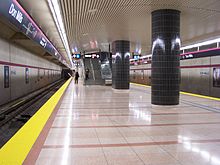
Opened in 2002, the Sheppard subway runs under Sheppard Avenue from Sheppard–Yonge station to Don Mills station. The line was under construction when a change in provincial government threatened to terminate the project, but Mel Lastman, the last mayor of the former City of North York (today part of Toronto), used his influence to save the project. Despite the construction of many high-rise residential buildings along the line since its opening, ridership remains low resulting in a subsidy of $10 per ride.[citation needed] The line was intended to be extended to Scarborough Centre station, but because of the low ridership and the cost of tunnelling, there was a plan to extend rapid transit eastwards from Don Mills station via a surface light rail line, the Sheppard East LRT. However, in April 2019, Premier Doug Ford announced that the provincial government would extend Line 4 Sheppard to McCowan Road at some unspecified time in the future, thus replacing the proposed Sheppard East LRT.[26] Line 4 Sheppard is also the only subway line in Toronto not to have any open sections.
Line 5 Eglinton
[edit]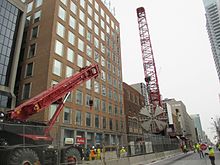
Metrolinx is funding the 19-kilometre (12 mi) Line 5 Eglinton, a light rail line along Eglinton Avenue. From Mount Dennis in the west to Brentcliffe Road (east of Laird Drive), the line will run almost entirely underground where Eglinton Avenue is generally four to five lanes wide. From east of Brentcliffe Road to Kennedy station, the line will operate on the surface in a reserved median in the middle of Eglinton Avenue, where the street is at least six lanes wide. Building on the surface instead of tunnelling reduces the cost of construction on the eastern end of the line. The average speed of the line is expected to be 28 kilometres per hour (17 mph); as a comparison, the average speed of the heavy-rail Line 2 Bloor–Danforth is 32 kilometres per hour (20 mph). The Eglinton line originated from Transit City, a plan sponsored by then–Toronto mayor David Miller, to expedite transit improvement by building several light rail lines through the lower density parts of the city. Of the light rail lines proposed, only the Eglinton and Finch West lines are under construction as of 2022[update]. Line 5 was expected to be completed in 2024, though it has since been delayed.[14]
Line 6 Finch West
[edit]Line 6 Finch West, also known as the "Finch West LRT", is an under-construction line being built by Mosaic Transit Group along Finch Avenue.[27][28] It is to be operated by the Toronto Transit Commission and was also part of the Transit City proposal announced on March 16, 2007. The 11-kilometre (6.8 mi), 18-stop line is to extend from Finch West station on Line 1 Yonge–University to the north campus of Humber Polytechnic (formerly Humber College). The line is forecast to carry about 14.6 million rides a year or 40,000 a day by 2031. Construction on this line began in 2019.[17] It was scheduled for completion in the first half of 2024, with an estimated cost of $1.2 billion, though it has since been delayed.
Ontario Line
[edit]Ontario Line is an under-construction 15.6-kilometre (9.7 mi) subway line from Exhibition station to Science Centre station, providing a second rapid transit line through the Financial District and downtown core. Although a subway line along Queen Street was first proposed in the early 1900s, the Downtown Relief Line was first proposed in the mid-1980s. The Ontario Line project extends further west and north than previous proposals to serve more of the city. The line is scheduled for completion in 2031 at a cost of $17 to $19 billion.[19] Upon opening, the plan is for the line is take the "Line 3" moniker formerly used by Line 3 Scarborough.[20]
Major incidents
[edit]On March 27, 1963, there was an electrical short in a subway car's motor. The driver decided to continue operating the train, despite visible smoke in the affected car, until the train reached Union station. This decision resulted in the destruction of six subway cars and extensive damage to the tunnel and signal lines west of Union station. Following this incident, safety procedures involving electrical malfunctions and/or fire in subway trains, were revised to improve safety and reduce the likelihood of a similar incident occurring.[citation needed]
On October 14, 1976, arson caused the destruction of four subway cars and damage to Christie station, resulting in the closure of part of the Bloor–Danforth line for three days, and the bypassing of Christie station for some time afterwards for repairs.[29][30]
On August 11, 1995, the TTC suffered the deadliest subway accident in Canadian history, known as the Russell Hill accident, on the Yonge–University line south of St. Clair West station. Halfway between St. Clair West and Dupont stations, a southbound Line 1 subway train hit the rear of a stationary train ahead of it.[31] Three people died and 100 other people were injured, some of them seriously. This led to a major reorganization at the TTC, with more focus on maintaining a "state of good repair" (i.e., an increased emphasis on safety and maintenance of existing TTC capital/services) and less on expansion.[32]
On July 24, 2023, the last car of a train on Line 3 Scarborough derailed south of Ellesmere station. There were 45 people on board, with five injuries reported.[33] The TTC closed the line while the cause of the accident, which was not immediately apparent, was investigated. Though the TTC planned to close Line 3 in November 2023, it announced on August 24 that the line would not reopen.[34]
Operations and procedures
[edit]Terminal station reversals and short turns
[edit]
The heavy-rail subway lines were built in multiple segments with multiple crossovers. These are typically used for reversals at terminal stations, and allow arriving and departing trains to cross to and from the station's farside platform. They are also used for short turning trains at some through stations in order to accommodate emergency and planned service suspensions. Planned service suspensions generally occur on weekends for planned maintenance activities that are impractical to perform overnight.[35] There is only one regular short turn service that occurs during the morning rush hour on Line 1 Yonge–University when some northbound trains short turn at Glencairn station.[36]
On Line 3 Scarborough, light metro trains were not able to switch direction except at the ends of the line as there were no intermediate crossovers between the two termini. Thus, no short turns on Line 3 were possible.
Door operation
[edit]The heavy-rail subway lines use either a one- or two-person crew. With two-person train operation, an on-board train guard at the rear of the train is responsible for opening and closing the subway car doors and making sure no one is trapped in a door as the train leaves a station. From the subway's inception in 1954 to 1991, the train guard notified patrons that the subway car doors were closing with two short blasts from a whistle.[37] With one-person train operation (OPTO), one person operates the train as well as the doors.[38] The TTC notes that modern technology now allows one person to safely operate the train and close the doors, and that OPTO is in use in many major cities with large subway systems such as the London Underground, the Paris Metro, the Chicago "L" and the Montreal Metro.[39]
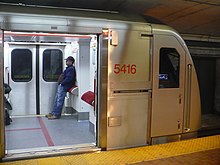
Initially, all the heavy-rail subway lines (1, 2 and 4) used two-person train operation. On October 9, 2016, Line 4 Sheppard was converted to OPTO.[38] On August 1, 2021, the TTC tested OPTO on a portion of Line 1 on Sundays only. Effective November 21, 2021, the TTC introduced OPTO seven days per week on Line 1 between Vaughan Metropolitan Centre and St. George stations. Between St. George and Finch stations, the TTC continued using two-person train operation[40]: 00:15:38 until the full conversion of the line to OPTO on November 20, 2022.[41] From its opening in 1985 to its close in 2023, trains on Line 3 Scarborough were operated by one person.
According to a 2020 survey conducted by the Amalgamated Transit Union Local 113, two-thirds of Torontonians surveyed opposed the TTC's plan to eliminate the train guard on Line 1, and three-quarters of Torontonians disapproved of the fact that the public was not consulted when train guards were removed from Line 4's daily operations in 2016, citing safety concerns, among other issues, as key reasons motivating their response.[42][43]
In 1991, as a result of lawsuits,[citation needed] electronic chimes, in the form of a descending arpeggiated major triad and a flashing pair of orange lights above the doorway, added for the hearing impaired, were tested and gradually introduced system-wide during the 1990s. The Toronto Rocket trains use the same door chimes and flashing orange lights as the older trains do, and also plays the additional voice announcement, "Please stand clear of the doors". Those chimes have become synonymous with the TTC and Toronto in general to the point that the CBC Radio One local afternoon show, Here and Now, includes them in its theme music.[citation needed]
Entering a station
[edit]There are several basic procedures that need to be completed once a train has entered a station. On TTC's Line 2, several symbols of different colours are installed on the station wall for the crew to use as a reference in positioning the train in the platform. A red circle, located at the train exit end of the platform, should be directly in front of the train operator's cab window when the train is aligned properly. A green triangle, located at the opposite end of the platform, is provided as a reference to the train guard that shows that the train is correctly aligned.[44] Before opening the train doors, the guard lowers the cab window and points their finger out the window toward the green triangle when the cab is lined up with the triangle. If the train is not lined up properly, the guard is not permitted to open the doors.[45]
To operate the doors, the guard is first required to insert and turn a key. This action provides system control to the door control panel. The doors are then opened by pushing buttons. After the doors are opened, the guard is required to stick their head out the cab window to observe passengers boarding and exiting. The train doors remain open for at least 15 seconds.[44]
When the guard determines that boarding is complete, the doors are closed. Electronic chimes and flashing lights are turned on, then the automated announcement "please stand clear of the doors" is played over the train's public address system, and finally the doors are closed. The chimes provide a clear notification and warning to passengers that the doors are closing and are played before the automated announcement is played, because such announcements may not be heard when the station is crowded.[44]
After the doors are closed, the guard provides a signal to the train operator that the train can proceed. The signal is in the form of a green light that turns on inside the operating cab. When the doors are closed, a light turns on in the operating cab. The guard is instructed to visually observe the platform while the train departs the station. The distance for this visual inspection is typically three car lengths. An orange triangle[45] installed on the station wall indicates the location where the guard may stop observing the platform and pull their head back into the cab.[44] This is done to ensure that no passengers are being dragged along by the train.[44]
Platform markers
[edit]All staffed subway operations must verify that the train is properly berthed before the doors are opened. At each subway platform, a set of three 15-centimetre-wide (6 in) platform markers are affixed onto the platform wall. The train operator and guard use them to position the train.
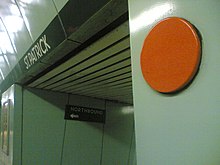
The current platform markers used for Lines 1, 2, and 4 are as follows:[46][38]
- Circular red disk (Lines 1, 2, and 4)—This marker is typically mounted on the station platform wall to assist the train operator in positioning the train in the station. When the operator's window is aligned with the red disk, the train is properly berthed in the station.
- Green triangle (Lines 1 and 2)—This marker is typically mounted on the station platform wall to indicate to the guard, who is positioned in the trailing car, that it is safe to open the doors. When the guard's window is aligned with this marker, the guard must confirm the stop position by physically pointing to the green triangle. If the guard cannot see the green triangle, they are not permitted to open the train doors.
- Orange triangle (Lines 1 and 2)—This marker is typically mounted on the station platform wall to assist the guard, who is positioned in the trailing car, to observe the platform for the required distance as the train is moving to exit the station. When the guard sees this triangle, they can cease observations. The distance between the green and orange triangles is typically the length of three rail cars.
Prior to 2017, when subway guards operated the doors from the fifth car instead of the trailing car in the T1 trains on Line 2, different platform markers were used. The following markers have now fallen into disuse as a result of a March 2017 policy change[47] that required all guards to work from the trailing car on Line 2:
- Circular green disk (Line 2)—This marker was mounted on the station platform wall in front of the guard's window in the fifth car from the lead unit. It indicated to the guard that the train was properly berthed.[48] The guard was required to point to the circle before opening the doors to confirm the stop position.[49]
- Circular orange disk (Line 2)—This marker was mounted on the station platform wall to indicate to the guard when they could cease train departure platform observations. At this point, the guard closed the cab window.[48]
Service frequency
[edit]| Line | Off-peak frequency[5] | Rush hour frequency[5] |
|---|---|---|
| 3 min 40 s – 6 min | 2 min 50 s | |
| 3 min 45 s – 6 min | 3 min | |
| 5 min 30 s | ||
During rush hour, up to 65 trains are on Line 1 simultaneously, 45 trains on Line 2, and 4 trains on Line 4. During non-rush hour periods, there are 30–46 trains on Line 1 at any one time.
On weekdays and Saturdays, subway service runs from approximately 6:00 am to 1:30 am; Sunday service begins at 8:00 am. Start times on holidays may vary.
Station announcements
[edit]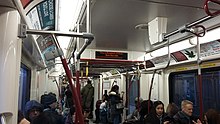
On January 8, 1995, train operators began to announce each stop over the train's speaker system as a result of pressure from advocacy groups for the visually impaired, but announcements were sporadic until the TTC began to enforce the policy circa 2005. Later, automated announcements were implemented under further pressure from the advocacy groups.[50][51] All Toronto subway trains use an automated system to announce each station, which is played twice over the speaker system: when the train departs a station (e.g. "The next station is: Dufferin, Dufferin station") and when it arrives at the following station (e.g. "Arriving at: Dufferin, Dufferin station"). In addition, the TTC's Toronto Rocket subway trains provide visible and audible automatic stop announcements. Unlike the other trains, the Toronto Rocket trains also announce connections to other TTC subway lines, such as "Change for Line 2", and terminus stations, "This is a terminal station" where applicable. As of 2015[update], they also announce, except at terminus stations, which side the train doors will open on at each stop based on the direction of train travel.[51]
Winter operations
[edit]Switches and power rails are vulnerable to malfunction under extreme winter conditions such as heavy snow or freezing rain. During such events, the TTC runs "storm trains" overnight along subway lines to keep power rails clear of ice. The TTC also has trains to apply an anti-freeze to the power rail once freezing rain starts.[52]
These precautions were also used on Line 3 Scarborough, which used two power rails.[52] After reviewing operations during the winter of 2018–2019, the TTC decided to change its procedures for Line 3. Thus, about two hours before an expected storm, the TTC would decide whether to shut down Line 3 and replace it with bus service.[53] Just before the storm of February 2, 2022, the TTC replaced all Line 3 trains with 25 buses.[54]
To keep switches in the yards from freezing, crews use switch heaters and manually monitor them to ensure they stay in working order during winter storms. Workcars are run as storm trains within the yards to prevent ice from building up on the power rails.[52] The TTC stores subway trains in tunnels along main lines rather than in exterior yards.[54]
Stations
[edit]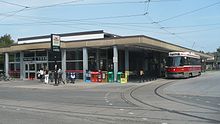
The Toronto subway has 70 stations across three lines. Most stations are named for the nearest major arterial road crossed by the line in question. A few are named for major landmarks, such as shopping centres or transportation hubs, served by the station. The stations along the University Avenue section of Line 1 Yonge–University, in particular, are named entirely for landmarks and public institutions (Museum, Queen's Park, and Osgoode) and major churches[citation needed] (St. Patrick and St. Andrew). All trains, except for short turns, stop at every station along their route and run the entire length of their line from terminus to terminus. Nearly all stations outside the central business district have terminals for local TTC bus routes and streetcar routes situated within their fare-paid areas. All regular TTC bus and streetcar routes permit free transfers both to and from connecting subway lines.
By December 23, 2016, Presto card readers had been installed in at least one priority subway station entrance across the TTC network.[55] Throughout 2017 and into mid-2018, the remaining subway station entrances that still use legacy turnstiles (which were retrofitted with Presto readers between 2010 and 2015) and the "floor-to-ceiling" revolving turnstiles (found in automatic/secondary entrances, which do not have Presto readers on them) were replaced by the new Presto-equipped "glass-paddle" fare gates.
Accessibility
[edit]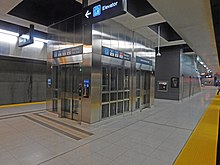
Most of the Toronto subway system was built before wheelchair access was a requirement under the Ontarians with Disabilities Act (ODA). However, all subway stations built since 1996 are equipped with elevators, and seventy percent (56 of 75) of Toronto's subway stations are now accessible following upgrade works to add elevators, wide fare gates, and access doors to the station, including the stations on the closed Line 3 Scarborough.[56]
In 2021, the TTC planned to make all of its stations accessible by 2025.[56] By comparison, the Montreal Metro plans for all stations to be accessible by 2038,[57] the Chicago "L" plans for all stations to be accessible in the 2030s,[58] and the New York City Subway plans for 95 percent of stations to be accessible by 2055.[59]
All TTC trains offer level boarding for customers with wheelchairs and other accessibility needs, with priority seating and dedicated wheelchair areas onboard each train.[60]
Cleanliness
[edit]The May 2010 TTC cleanliness audit of subway stations found that none of them meets the transit agency's highest standard for cleanliness and general state of repair. Only 21 stations scored in the 70- to 80-percent range in the TTC's cleanliness scale, a range described as "Ordinary Tidiness", while 45 fell in the 60- to 70-percent range achieving what the commission describes as "Casual Inattentiveness". The May audit was the third in a series of comprehensive assessments that began in 2009. The commission announced a "Cleaning Blitz" that would add 30 new temporary cleaners for the latter part of 2010 to address major issues and has other action plans that include more full-time cleaners, and new and more effective ways at addressing station cleanliness.[61][62]
The TTC implemented stricter cleanliness protocols during the COVID-19 pandemic.[63]
Design and public art
[edit]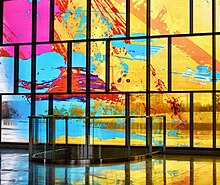
According to a 1991 CBC report, "aesthetics weren't really a priority" on Toronto's subway system, describing stations as "a series of bathrooms without plumbing".[64] Since that time, Toronto's subway system has had over 40 pieces installed in various subway stations. More art appeared as new stations were built and older ones were renovated.
In 2004, USA Today said of the Sheppard subway line: "Despite the remarkable engineering feats of this metro, known as Sheppard Subway, [it is] the art covering walls, ceilings, and platforms of all five stations that stands out. Each station is 'a total art experience where artists have created imaginative environments, uniquely expressing themes of community, location, and heritage' through panoramic landscapes and ceramic wall murals."[65]
Internet and mobile phone access
[edit]Wireless service implementation
[edit]In 2012, the TTC awarded a contract to BAI Communications Canada to design, build and maintain a celular and Wi-Fi system along Toronto subway lines. BAI agreed to pay $25 million to the TTC over a 20-year period for the exclusive rights to provide the service. BAI in turn would sell access to the cellular system to other carriers.[66][67]
On December 13, 2013, Wi-Fi Internet access was launched at Bloor–Yonge and St. George stations. The ad-supported service (branded as "TConnect") was provided by BAI Canada. The TTC and BAI Canada planned to offer TConnect at all underground stations.[66] Commuters had to view a video advertisement to gain access to the Internet.[68] It was expected that all of the 70 subway stations would have service by 2017, as well as the six stations along the Line 1 extension to Vaughan.[69] From early December 2015 to late January 2016, users of TConnect were required to authenticate using a Twitter account, with Twitter's Canadian operations sponsoring the TConnect Wi-Fi network.[70] Users of the network could sign in to enable an automatic Wi-Fi connection for 30 days. This arrangement was resumed on an optional basis from July 2016 to early December 2016. By August 2017, Wi-Fi was available at all existing stations and would be available in all future stations.[71]
On June 17, 2015, the TTC announced that Wind Mobile (later rebranded Freedom Mobile) customers would be able to access cellular connectivity at some TTC subway stations. Service was initially between Bloor–Yonge and St. George stations on Line 1, and between Bloor–Yonge and Spadina stations on Line 2.[72] Other carriers declined to use the BAI cellular system because of the price BAI was asking for access.[67]
In April 2023, Rogers Communications took over BAI Communications and honoured existing access to Freedom Mobile customers. In August 2023, Rogers implemented 5G wireless service at all the TTC's downtown stations and within the tunnels between them.[73] In September 2023, the federal government imposed new licence conditions requiring that cellphone and data services be available on the entire subway network by the end of 2026 and that all carriers, including Telus and Bell, were to have access to it.[73] On October 2, 2023, Bell and Telus offered its cellular customers access to the subway's 5G system.[74]
By November 2023, wireless service had been expanded to all TTC stations and to the tunnels between Sheppard West and Vaughan Metropolitan Centre stations, but only for Rogers and Freedom customers. Bell and Telus customers continued to have wireless service at a limited number of stations.[75] In December 2023, Telus and Bell reached a deal with Rogers to provide their customers the same subway wireless services as Rogers and Freedom customers.[76]
Rogers and the TTC decided to end TConnect, the free public Wi-Fi service, on December 27, 2024, due to low usage and the cost of upgrading it.[77][78]
Current wireless services
[edit]As of December 22, 2023[update], Rogers 5G wireless service is available in all subway stations for customers of Rogers, Freedom Mobile, Telus and Bell, but service access between stations is limited. 5G wireless service is available in open sections, as well as between Bloor–Yonge and Dupont stations on Line 1, and between Castle Frank and Keele stations on Line 2. 5G service is also available in the tunnels between Sheppard West and Vaughan Metropolitan Centre stations.[75][76] Wireless service is available to customers of Rogers, Freedom Mobile, Bell and Telus (including flanker brands of these companies such as Koodo and Virgin Plus).[74] This wireless service is not free, and users require a subscription from one of the four aforementioned carriers, given the lack of subsidized wireless plans in Ontario.[77]
Naming
[edit]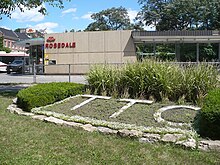
The TTC considers multiple different factors when they name stations and stops for subway and LRT stations. They consider local landmarks, the cross streets of the station, distinct communities of the past and present in the vicinity of the station, names of other stations in the system, and the grade of the station.[79]
Metrolinx uses five criteria for naming stations and stops. These are:[80]
- Simplicity
- Names must be logical and relevant to the area the station is built in
- Names should be relevant for the life of the station
- Names should help passengers locate themselves within the region
- Uniqueness
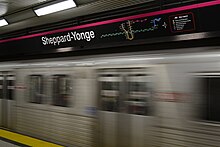
Metrolinx will use the word "stop" in place of "station" at 10 of the 25 stations along the first phase of Line 5, particularly those that are not grade-separated.[81]
Rolling stock
[edit]The following table shows the vehicle type by line:[82]
| Line | Vehicle | Number of cars | Cars per train | Passenger capacity per train |
|---|---|---|---|---|
| Toronto Rocket (TR) | 456[82][c] | 6[83] | 1080[83] | |
| T series (T1) | 370[82] | 6[83] | 1000[83] | |
| Toronto Rocket (TR) | 24[82][d] | 4[84] | 720[e] | |
| Under construction | ||||
| Flexity Freedom | 76[85] | 2[86] | 163–490[86] | |
| Alstom Citadis Spirit[87] | 17[87] | 1 | 336[88] | |
Heavy rail stock
[edit]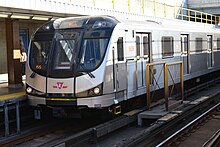
Line 1 Yonge–University and Line 4 Sheppard operate using the newest version of Toronto's subway cars, the Toronto Rocket, while Line 2 Bloor–Danforth uses the older T1 subway trains.[89]
The TTC's original G-series cars were manufactured by the Gloucester Railway Carriage and Wagon Company. All subsequent heavy-rail subway cars were manufactured by Bombardier Transportation or one of its predecessors (Montreal Locomotive Works, Hawker Siddeley, and UTDC). All cars starting with the Hawker Siddeley H series in 1965 have been built in Bombardier's Thunder Bay, Ontario, plant. The final H4 subway cars were retired on January 27, 2012.[90] This was followed by the retirement of the H5 subway cars, which had their final in-service trip on June 14, 2013, and the H6 retirement, which followed one year later with a final run on June 20, 2014.
Following the introduction of the Toronto Rocket trains on Lines 1 and 4, all the T1 trains were moved to Line 2. The T1s were expected to last until 2026.[91][92] By the end of 2019, the TTC had proposed an overhaul to extend the T1 fleet's life by 10 years[93] at an estimated cost of $100 million.[94] By mid-2020, the TTC had started the design phase for a new generation of subway trains to replace the T1 fleet on Line 2 Bloor–Danforth. In late 2021, the TTC expected that the new trains would be introduced between 2026 and 2030,[95] at an estimated cost of $1.6 billion.[96]: 30 On October 13, 2022, the TTC issued a request for proposals to construct 480 new subway cars (80 six-car train sets) of a design different from the T1 and Toronto Rocket fleet for delivery between 2027 and 2033.[97][98] As of 2022[update], the TTC plans to overhaul the T1 fleet if newer trains cannot be delivered in time.[94]
The Ontario Line will use smaller train sets and a smaller gauge than those used on the Toronto subway system. By using driverless trains with automatic train control (ATC), Metrolinx expects the line to be as frequent as the existing subway lines despite using smaller, lighter trains. In conjunction with ATC, stations will have platform-edge doors for safety, also allowing riders to exit and enter trains more quickly.[99] The trains will be manufactured by Hitachi Rail, similar to trains in Copenhagen or Rome.[100]
Light metro stock
[edit]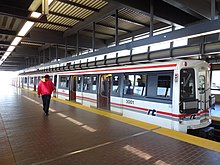
Line 3 Scarborough used 28 S-series trains built by the Urban Transportation Development Corporation (UTDC) in Millhaven, Ontario. These Intermediate Capacity Transit System (ICTS) trains were Mark I models, similar in design to the original trains found on the Vancouver SkyTrain and the Detroit People Mover. These were the original vehicles on the line and were in service from the line's opening in 1985 to its closure in 2023. Because of the trains' age, they were refurbished for operation and initially intended to last until the extension of Line 2 Bloor–Danforth was built. In February 2021, the TTC announced plans to accelerate the retirement of Line 3, intending to close it in 2023. This was due to delays in planning and construction of the Line 2 extension (which was then projected to open in 2030 at the earliest) along with the increasing difficulty of performing critical maintenance work on the trains.[101][102][103] Following an initial temporary closure owing to a derailment in July 2023, the TTC decided in August 2023 not to reopen the line.[104] The TTC proposed selling some of these trains to the Detroit People Mover, which uses a similar technology.[105]
Light rail stock
[edit]
Metrolinx plans to use 76 Bombardier Flexity Freedom low-floor, light-rail vehicles for Line 5 Eglinton; however, 44 Alstom Citadis Spirit vehicles may be used if Bombardier is unable to deliver the Flexity Freedom on time. Such a substitution would require modifications to Line 5, especially the maintenance facility, as the Citadis Spirit is longer than the Flexity Freedom. Metrolinx intends to use 17 Citadis Spirit vehicles on Line 6 Finch West instead of the Flexity Freedom.[106]
| Vehicle | Alstom Citadis Spirit | Bombardier Flexity Freedom |
|---|---|---|
| Length | 48.4 m (159 ft) | 31.9 m (105 ft) |
| Maximum capacity | 292 | 164 |
| Maximum speed | 100 km/h (62 mph) | 80 km/h (50 mph) |
Technology
[edit]| Technology | Lines used | Vehicle floor type | Track gauge | Line voltage | Electrical feed | Electrical pickup |
|---|---|---|---|---|---|---|
| Heavy rail | High floor | 4 ft 10+7⁄8 in (1,495 mm) Toronto gauge | 600 V DC | Third rail | Bogie-mounted shoe | |
| Light rail | Low floor | 1,435 mm (4 ft 8+1⁄2 in) standard gauge | 750 V DC | Overhead wire | Roof-mounted pantograph |
The heavy rail and light metro lines have some characteristics in common: Such lines are fully isolated from road traffic and pedestrians; the station platforms are covered, and the trains are boarded through many doors from high platforms within a fare-paid zone separated by faregates.
In contrast, the surface portions of the light rail lines (Lines 5 and 6) will fit into the street environment. Light-rail tracks will be laid on the surface within reserved lanes in the middle of the street, and cross street intersections at grade. Surface stations will have simple, low-level platforms. However, like heavy rail and light metro, passengers will be able to board and alight the light rail trains by multiple doors.[107]
Line 3 Scarborough, a light metro, used a more complex technology than heavy rail, which a TTC document describes as follows:
- Track is the 5 rail system on direct fixation and car is powered by an induction or "reaction rail" situated between the running rails at the same top of rail elevation. There are two side contacting power rails +300V and −300V respectively situated a distance of about 14 in. from the closest gauge line of one running rail.[108]
Signals
[edit]Heavy rail
[edit]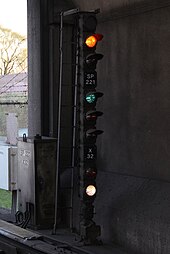
Fixed-block signalling was originally used on the Toronto subway since the opening of Toronto's first subway in 1954 and was the first signalling system used on Lines 2 and 4.[109][110] As of 2022, Lines 2 and 4 use fixed-block signalling but Line 1 no longer does. Fixed-block signalling uses automatic signalling to prevent rear-end train collisions, while interlocking signals are used to prevent collisions from conflicting movements on track crossovers.
As of September 24, 2022[update], automatic train control (ATC) has been implemented along the entire length of Line 1.[111] In 2009, the TTC awarded a contract to Alstom to upgrade the signalling system of the existing section of Line 1, as well as equip its extension into Vaughan, with moving block–based communications-based train control (CBTC) by 2012.[112] The estimated cost to implement ATC on Line 1 was $562 million, $424 million of which was funded by Metrolinx.[109] The first section of the "Urbalis 400" ATC system on Line 1 entered revenue service on December 17, 2017, between Sheppard West and Vaughan stations, in conjunction with the opening of the Toronto–York Spadina subway extension (TYSSE) project.[113]
The benefits of ATC on Line 1 are:
- a reduced headway between trains from 2.5 minutes to 2 minutes during rush hours, allowing a 25 percent increase in the number of trains that can operate[109]
- fewer signal-related delays relative to the old fixed-block system[111]
- more efficient use of electricity, thus reducing operational costs[111]
- allowing single-track, bidirectional operation for trains in passenger service, albeit with reduced frequency, to allow for off-hour maintenance of the opposite track[114][115][116]
The TTC has plans to convert Line 2 to ATC by 2030, subject to the availability of funding.[117]
Light metro
[edit]Line 3 Scarborough was equipped with automatic train control from the outset, using the same SelTrac IS system as Vancouver's SkyTrain, meaning it could be operated autonomously. However, the TTC opted to equip each S-series train with an operator on board for door monitoring.[21]
The future Ontario Line will use automatic train control with driverless trains. Its stations will be equipped with platform screen doors.[118]
Light rail
[edit]When completed, Line 5 Eglinton will use Bombardier Transportation's Cityflo 650 CBTC automatic train control on the underground section of the line between Laird station and Mount Dennis station, along with the Eglinton Maintenance and Storage Facility adjacent to Mount Dennis station.[119]
Track
[edit]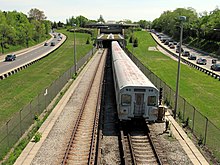
Lines 1, 2 and 4 – the heavy-rail lines – run on tracks built to the Toronto gauge of 4 ft 10+7⁄8 in (1,495 mm), the same gauge used on the Toronto streetcar system. According to rail historians John F. Bromley and Jack May, the reason that the Yonge subway was built to the streetcar gauge was that between 1954 and 1965, subway bogies were maintained at the Hillcrest Complex, where the streetcar gauge was used for shop tracks. The Davisville Carhouse was not equipped to perform such heavy maintenance, and the bogies would be loaded onto a specially built track trailer for shipment between Davisville and Hillcrest. This practice ceased with the opening of the shops at the Greenwood Yard in 1965.[120]
Line 3 Scarborough used standard-gauge tracks, as the ICTS design for the line did not allow for the interchange of rail equipment between the traditional subway system and Line 3.[121] When its ICTS vehicles needed anything more than basic service (which could be carried out at the McCowan Yard), they were carried by truck to the Greenwood Subway Yard.[122]
The Line 5 Eglinton and Line 6 Finch West LRT lines will be constructed with standard-gauge tracks. The projects are receiving a large part of their funding from the Ontario provincial transit authority Metrolinx and, to ensure a better price for purchasing vehicles, it wanted to have a degree of commonality with other similar projects within Ontario.[123] The Ontario Line subway will similarly be built to standard gauge.
Facilities
[edit]The subway system has the following yards to provide storage, maintenance and cleaning for rolling stock. All yards are located above ground.
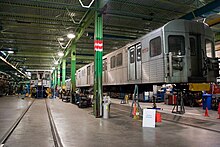
| Facilities | Year opened |
Lines served |
Remarks |
|---|---|---|---|
| Davisville Yard | 1954 | ||
| Greenwood Yard | 1966 | ||
| Keele Yard | 1966 | Closed in 1978; reopened June 18, 2017[124] | |
| McCowan Yard | 1985 | Line in decommissioning phase | |
| Wilson Yard | 1977 | ||
| Eglinton MSF | TBA | Line under construction | |
| Finch MSF | TBA | Under construction |
In the second quarter of 2018, the City of Toronto moved to expropriate Canadian Pacific Railway's disused Obico Yard at 30 Newbridge Road / 36 North Queen Street in Etobicoke for use as a potential future yard at the western end of Line 2 Bloor–Danforth.[125] The yard is situated immediately to the southwest of Kipling station, the western terminus of Line 2.
Safety
[edit]
There are several safety systems for use by passengers in emergencies:
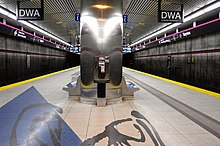
- Emergency alarms (formerly "Passenger assistance alarms"): Located throughout all subway trains – When the yellow strip is pressed, an audible alarm is activated within the car, a notification is sent to the train crew and the Transit Control Centre, which in turn dispatches a tiered response. An orange light is activated on the outside of the car with the alarm for emergency personnel to see where the problem is.[126]
- Emergency power cut devices: Marked by a blue light, located at both ends of each subway platform – For use to cut DC traction power in the event a person falls or is observed at track level or any emergency where train movement into the station would be dangerous. These devices cut power in both directions for approximately one station each way.[127]
- Emergency stopping mechanisms (PGEV: passenger/guard emergency valve): Located at each end of each subway car (with exception of the Toronto Rocket trains) – Will activate the emergency brakes of the vehicle stopping it in its current location (for use in extreme emergencies, such as persons trapped in doors as train departs station, doors opening in the tunnel, derailments etc.)[127]
- Passenger intercoms: Located on subway platforms and near/in elevators in stations – For use to inform station collector of security/life safety issues[126]
- Automated external defibrillators (AEDs): Located in several subway stations near collector booths – For use in the event someone suffers cardiac arrest
- Public telephones: Located in various locations in all stations, and at the Designated Waiting Area's on each subway platform. Emergency calls can be made to 911 toll free.[126] Phones located at the DWAs also include a "Crisis Link" button that connect callers, free of charge, to a 24-hour crisis line in the event that they are contemplating self-harm.
Stations with high platforms have a crawl space under the platform edge which the TTC recommends that a person who has fallen onto the track use to avoid an oncoming train. Lying flat between the two rails is not recommended due to shallow clearances. The platform edge has a yellow strip behind which passengers should wait to avoid a fall.[128]
Stations do not have platform screen doors, a feature which for Lines 1, 2 and 4 would require station modification, automatic train control (ATC) and a $1.35-billion investment which is not funded as of 2022[update].[128] ATC is needed to stop trains at a precise position along the platform to line up train doors with platform doors.[129] Since September 24, 2022[update], ATC has been activated along the entire length of Line 1; thus, it would be possible to install platform screen doors along Line 1.[111] The future Ontario Line will be built to operate with ATC and will feature platform doors from its opening.[118] The benefits of platform doors would be:[129]
- Blocking those attempting suicide or trespassers from the tracks: it takes 70 to 90 minutes to resume operations each time there is a personal injury at track level
- Eliminating fires from debris falling on the tracks and the third rail
- Allowing trains to enter crowded stations at speed, thus speeding up service along the line
The light-rail Line 5 Eglinton will use a guideway intrusion detection system (GIDS) to detect trespassers on the tracks on the underground sections of the line. When GIDS detects a trespasser on the tracks, it will issue an audio warning to the trespasser, provide live CCTV video to central control, and automatically stop the train without driver intervention. Each station will be equipped with multiple GIDS scanners along the station platform. There will also be GIDS scanners at each tunnel portal. In addition, there will be scanners within the yellow tactile strips along the platform edge to issue an audio warning if a person steps on it before the train has arrived.[130]
A trial program began in 2008 with Toronto EMS and has been expanded and made permanent, with paramedics on hand at several stations during peak hours: Spadina and Bloor–Yonge (morning peak: 7 am–10 am) and Union and Eglinton (evening peak: 2 pm–6 pm).[131]
By September 2023, the TTC was making naloxone available at each subway station so that designated trained TTC staff could attempt to rescue anyone having a drug overdose. Kits containing naloxone nasal spray would be stored at station collector booths. TTC special constables would carry naloxone.[132]
Training
[edit]Subway operators begin their training at Hillcrest with a virtual reality mockup of a Toronto Rocket car. The simulator consists of the operator cab with full functions, a door and partial interior of a subway car. The simulator is housed in a simulated subway tunnel. Construction of a new subway training centre is underway at the Wilson Complex, as part of the Toronto Rocket subway car program.[133]
Expansion plans
[edit]| Line | Opening | Stations | Length | Technology | Track gauge | Electrification |
|---|---|---|---|---|---|---|
| 2030/31 | 6 | 8 km (5.0 mi) | Heavy rail | Toronto gauge (1,495 mm) | 600 V DC third rail | |
| 2034[b] | 27 | 18.6 km (11.6 mi) | Light rail | Standard gauge (1,435 mm) | 750 V DC overhead line | |
| TBD | TBD | TBD | Heavy rail | Toronto gauge (1,495 mm) | 600 V DC third rail | |
| TBD | TBD | TBD | Heavy rail | Toronto gauge (1,495 mm) | 600 V DC third rail | |
| TBD | TBD | TBD | Light rail | Standard gauge (1,435 mm) | 750 V DC overhead line | |
| TBD | TBD | TBD | Light rail | Standard gauge (1,435 mm) | 750 V DC overhead line |
Provincially supported projects
[edit]
On April 10, 2019, Ontario premier Doug Ford announced rapid transit–related projects that the Province of Ontario would support with either committed or future financing.[134] One such project is the Ontario Line, a proposed 15.5-kilometre (9.6 mi) rapid transit line that has succeeded the Relief Line proposal. Initially, the project was projected to be completed in 2027,[135] but this was later pushed back to 2030.[136] A groundbreaking ceremony for the Ontario Line was held on March 27, 2022.[137]
The Line 5 West Extension to Pearson Airport is a proposal to extend Line 5 Eglinton from its terminus at Mount Dennis station west along Eglinton Avenue West to the proposed Pearson Transit Hub in Mississauga. In April 2019, Ford said that he would commit funds for this proposal.[138]
The Yonge North Subway Extension (YNSE) is a proposal to extend Line 1 Yonge–University north along Yonge Street from Finch station, the existing terminus of Line 1, to near Highway 7 in Richmond Hill. There would be new stations at Steeles Avenue, Clark Avenue, between Highway 7 and Highway 407 near Langstaff GO Station and Richmond Hill Centre Terminal (dubbed "Bridge station"), and High Tech Road.[139][140] The extension was proposed in the province's 2007 MoveOntario 2020 plan. A major problem with this proposal was that Line 1 was at capacity, and the TTC said in 2016 that the proposed Relief Line and SmartTrack would both need to be in service before opening the YNSE.[141] In 2020, a preliminary agreement was signed between the Ontario provincial government and York Region that anticipated the completion of the extension by approximately 2030.[142]
The Scarborough Subway Extension (SSE) is a proposal to replace Line 3 Scarborough with an eastward extension of Line 2 Bloor–Danforth. On October 8, 2013, Toronto City Council conducted a debate on whether to replace Line 3 with a light rail line or a subway extension. In 2014, the city council voted to extend Line 2 to Scarborough City Centre, which would result in the closure of Line 3.[143][144] The SSE would be 6 kilometres (3.7 mi) long and add one new station to Line 2 at Scarborough Town Centre. TTC and city staff finalized the precise route of the SSE in early 2017.[145] In 2019, the Government of Ontario proposed a modified version of the proposal now known as the Line 2 East Extension (L2EE). The L2EE is 7.8 kilometres (4.8 mi) long and adds three new stations, rather than one.[146] The proposed completion deadline for the project is between 2029 and 2030.[147]
The Line 4 East Extension to McCowan is a proposal to extend Line 4 Sheppard east along Sheppard Avenue East to McCowan Road, where it will connect with the Scarborough Subway Extension. Doug Ford said in April 2019 that he would commit funds related to this proposal.[148]
Other active proposals
[edit]The Eglinton East LRT is a City of Toronto proposal to construct an LRT line (separate from Line 5 Eglinton) from Kennedy station east to Malvern. This proposal was originally part of the cancelled Scarborough–Malvern LRT in Transit City. It would have stations at Eglinton GO and Guildwood GO, as well as the University of Toronto Scarborough campus.[149]
Inactive proposals
[edit]The Jane LRT is a proposed LRT line that would begin at Jane station on Line 2 and proceed north to Pioneer Village station on Line 1. While initially part of the cancelled Transit City plan, the Jane LRT is part of the 2018–2022 TTC Corporate Plan and tentatively referred to as Line 8.[150]
The Line 4 West Extension to Sheppard West station is a proposal that would extend Line 4 Sheppard west along Sheppard Avenue West to Sheppard West station, where it would link to Line 1 Yonge–University. It is currently listed as an "unfunded future rapid transportation project" in the City of Toronto's 2013 Feeling Congested? report.
The Line 6 East Extension to Finch station is a proposal that would extend Line 6 Finch West east along Finch Avenue West to Finch station, where it would link up with Line 1 Yonge–University. In March 2010, the Ontario government eliminated the proposed section of line between Finch West station and Finch station because of budget constraints. This section of the line was part of the original Transit City proposal. In 2013, this plan was revived as an "unfunded future rapid transit project" in the City of Toronto's Feeling Congested? report, meaning this extension may be constructed sometime in the future. The extension was later shown in the 2018–2022 TTC Corporate Plan with no timeline for completion.
Along with a proposal to extend Line 6 to Finch station, there was another proposal that would have extended the line farther to Don Mills station, where it would have provided a connection to Line 4 Sheppard. In May 2009, Metrolinx proposed that the line be extended from Finch station along Finch Avenue East and Don Mills Road into Don Mills station to connect with the Sheppard East LRT and create a seamless crosstown LRT line in northern Toronto to parallel the Eglinton Crosstown LRT (later designated Line 5 Eglinton) in central Toronto. The TTC said that a planning study would have commenced in 2010.
The Line 6 West Extension to Pearson Airport is a proposal that would extend Line 6 Finch West west to Pearson Airport, where it would provide a link to Line 5 Eglinton. In 2009, the TTC studied the feasibility of potential routings for a future westward extension of the Etobicoke–Finch West LRT to the vicinity of the Woodbine Live development, Woodbine Centre, and Pearson International Airport. This extension was later reclassified as a future transit project as described in the 2013 Feeling Congested? report by the City of Toronto. Metrolinx revealed in January 2020 that they would study a possible connection to the Pearson Transit Hub at Pearson Airport.[151]
Abandoned plans
[edit]The Queen subway line was a subway line first proposed in 1911. When Line 1 was first built, a roughed-in station was included under Queen station, with the intention that the Queen subway would be the city's second subway line. The route of the Queen subway line is included in the routes for both the Relief Line and the Ontario Line proposals.[150]
The Eglinton West line was a proposed subway line in the late 1980s on which construction began in the early 1990s. It was cancelled after the election of Mike Harris as premier of Ontario. Much of its planned route is included in Line 5 Eglinton.[150]
One proposed expansion of Line 2 Bloor–Danforth into Mississauga included eight potential stations stretching west from Kipling station to Mississauga City Centre, retrofitting some existing GO Transit stations. The plan was for the subway stations to open in 2011. Mississauga mayor Hazel McCallion and the Regional Municipality of Peel did not support the project.[152]
The Relief Line was a proposed heavy-rail subway line running from Pape station south to Queen Street East and then west to the vicinity of Toronto City Hall. The proposal included intermediate stations at Sherbourne Street, Sumach Street, Broadview Avenue, and another near Gerrard Square. In January 2016, alignment options and possible stations were still being studied, and the project was unfunded. Construction was expected to take about ten years to complete.[153] As early as 2008, Metrolinx chair Rob MacIsaac expressed the intent to construct the Relief Line to prevent overcrowding along Line 1.[154] Toronto City Council also expressed support for this plan.[155] In April 2019, the Government of Ontario under Doug Ford announced that the Ontario Line would be built instead of the Relief Line. As a result, TTC and City of Toronto staff suspended further planning work on the Relief Line in June 2019.[156]
Transit City
[edit]The Sheppard East LRT was a proposed light rail line running east from Don Mills station to Morningside Avenue in Scarborough. The line was to be 13 kilometres (8.1 mi) long with 25 surface stations and one underground connection at Don Mills station on Line 4 Sheppard. Construction of the Sheppard East LRT was to start upon completion of Line 6 Finch West.[157] However, in July 2016, the Toronto Star reported the Sheppard LRT had been deferred indefinitely.[85] In April 2019, Premier Doug Ford announced that the provincial government would extend Line 4 Sheppard to McCowan Road at some unspecified time in the future, replacing the proposed Sheppard East LRT.[26]
The Don Mills LRT was a proposed LRT line that would have headed north from Pape station along Don Mills to Don Mills station. Its route was later incorporated into the Relief Line and Ontario Line proposals.[150][additional citation(s) needed]
See also
[edit]Notes
[edit]- ^ a b Both Line 5 Eglinton and Line 6 Finch West have had a variety of opening dates announced that have subsequently been missed. As of December 2024,[update] there are no set opening dates for either line, with the TTC only stating that neither will open before June 2025.[8]
- ^ a b c d Estimated year of opening
- ^ 456 vehicles ordered for six-car TR trainsets, 444 delivered as of January 2017.
- ^ 24 vehicles ordered for 4-car TR trainsets, 16 delivered as of January 2017.
- ^ 4-car TR train capacity prorated from the capacity of the 6-car TR train.
References
[edit]Citations
[edit]- ^ a b c d e f g h i j k l m "2013 TTC Operating Statistics". Toronto Transit Commission. Archived from the original on August 16, 2021. Retrieved January 27, 2017.
- ^ a b "Toronto-York Spadina Subway Extension". TTC.ca. Archived from the original on August 19, 2021. Retrieved February 8, 2017.
- ^ "Transit Ridership Report Third Quarter 2024" (PDF). American Public Transportation Association. November 20, 2024. Retrieved November 23, 2024.
- ^ "Transit Ridership Report Fourth Quarter 2023" (PDF). American Public Transportation Association. March 4, 2024. Retrieved September 5, 2024.
- ^ a b c d e "Service Summary November 20, 2022 to January 7, 2023" (PDF). Toronto Transit Commission. November 20, 2022. Archived from the original (PDF) on December 25, 2022. Retrieved December 25, 2022.
- ^ "Eglinton Crosstown LRT". Metrolinx.com. Retrieved January 28, 2018.
- ^ "Scarborough Subway Extension". Metrolinx. January 2023. Retrieved January 28, 2023.
- ^ "TTC chair hints earliest opening date for Eglinton Crosstown LRT could be June 1". CityNews. December 3, 2024. Archived from the original on December 5, 2024.
- ^ "Traffic authorities from all over world see subway opened", Toronto Daily Star, March 30, 1954, p. 3.
- ^ "Scarborough Subway Extension". Metrolinx. Retrieved August 9, 2021.
- ^ Adel, Aaron; Bow, James (October 23, 2016). "The Sheppard Subway". Transit Toronto. Retrieved January 13, 2017.
- ^ "For a Greater Region – Eglinton Crosstown LRT". Metrolinx.
- ^ Kalinowski, Tess (September 24, 2015). "Eglinton Crosstown to open a year later than expected". Toronto Star. Retrieved September 24, 2015.
- ^ a b Ranger, Michael (May 16, 2023). "Eglinton Crosstown won't open until 2024, construction group to take legal action: Metrolinx". CityNews. Retrieved May 16, 2023.
- ^ "Eglinton Crosstown LRT could be $330 million over budget and open seven months late, internal documents warn". Toronto Star. December 30, 2019. Retrieved September 7, 2020.
- ^ "Metrolinx – Eglinton Crosstown West Extension". www.metrolinx.com. Retrieved March 2, 2023.
- ^ a b Thompson, John (September 18, 2019). "Ontario LRT Update". Railway Age.
- ^ "Finch West LRT likely won't be open to public until 2024 despite construction progress". CityNews. July 25, 2023.
Metrolinx officials say it's now looking likely the Finch West LRT won't be open to riders until the first half of 2024. However, they say crews are working to finish heavy construction by fall 2023.
- ^ a b "Ontario Line costs nearly double after awarding of latest contracts". Toronto Star. November 23, 2022.
- ^ a b "Future TTC Rapid Transit Map – 2031 Projection" (PDF). ttc.ca. TTC. February 10, 2021.
- ^ a b Bow, James (December 28, 2016). "The Scarborough Rapid Transit Line". Transit Toronto. Retrieved January 13, 2017.
- ^ Marchesan, John (August 24, 2023). "TTC says Scarborough Line 3 will not resume operation following derailment". City News Toronto. Retrieved August 24, 2023.
- ^ Moore, Oliver (February 10, 2021). "TTC board green-lights plan to close Rapid Transit line". The Globe and Mail. Retrieved August 9, 2021.
- ^ "TTC Subway/RT Route Histories – Transit Toronto – Content". transittoronto.ca. Retrieved March 15, 2022.
- ^ Byford, Andy (March 26, 2015). "Toronto-York Spadina Subway Extension – Schedule and Budget Change" (PDF). Toronto Transit Commission. Archived from the original (PDF) on April 11, 2015. Retrieved April 15, 2017.
- ^ a b "How Doug Ford's $28.5-billion transit overhaul compares with Toronto's existing plans". Toronto Star. April 10, 2019. Retrieved October 16, 2019.
- ^ "Aecon consortium selected as preferred proponent for the Finch West Light Rail Transit project in Toronto". AECON. Retrieved July 1, 2018.
- ^ "For a Greater Region – Finch West LRT". Metrolinx. Retrieved July 1, 2018.
- ^ Griffin, Doug. "Burned-out ruins of four Bloor subways cars are examined by firefighters at Christie subway station". Toronto Public Library. Toronto Star. Retrieved December 15, 2022.
- ^ Bow, James. "THE CHRISTIE STATION FIRE SUBWAY DIVERSION (OCTOBER 15–17, 1976)". Transit Toronto. Retrieved December 15, 2022.
- ^ Pelley, Lauren. "20 years after Russell Hill, Toronto's deadliest subway crash". Toronto Star. Retrieved April 23, 2019.
- ^ "Ten Years After – Toronto Star". Transit Toronto. August 6, 2005. Retrieved October 26, 2018.
- ^ "CityNews". toronto.citynews.ca. July 25, 2023.
- ^ "Scarborough RT officially shut down: TTC". CBC News. August 24, 2023. Retrieved August 24, 2023.
- ^ Byford, Andy (January 20, 2017). "Necessity of TTC subway closures explained". Toronto Transit Commission. Archived from the original on February 2, 2017. Retrieved January 23, 2017.
The new signal system will be introduced in phases from this fall and will be completed by the end of 2019 at which point we will undertake similar work on Line 2.
- ^ Monro, Steve (October 23, 2017). "TTC Service Changes Effective Sunday, November 26, 2017". Retrieved November 14, 2018.
- ^ TechnicaProductions (October 17, 2012), TTC M1s In Operation, retrieved April 14, 2019
- ^ a b c "TTC switching to single-operator model for Line 4 subway as of Oct. 9". CP24, Chris Fox, September 27, 2016
- ^ "OPTO". TTC. Retrieved September 25, 2022.
One-Person Train Operation (OPTO) is a modernizing step that allows the train Operator to perform all duties within the train cab. Updated technology will allow one crew member to safely drive the train and operate the doors. Major metropolitan cities have also migrated to OPTO: Paris, London, Chicago, Los Angeles, Montreal, Boston, Berlin, Madrid, Hong Kong and more.
- ^ "Toronto Transit Commission Board Meeting – November 29, 2021". Toronto Transit Commission. November 29, 2021.
- ^ "Line 1 (Yonge-University)–Service increase". Toronto Transit Commission. November 20, 2022. Archived from the original on November 19, 2022.
- ^ "Majority of Torontonians say no to TTC plan to remove subway guards: poll – 680 NEWS". www.680news.com. February 26, 2020. Retrieved April 6, 2021.
- ^ "Toronto - Torontonians' attitudes on eliminating subway guards and public consultation on TTC subway safety" (PDF). wemovetoronto.ca. February 25, 2020. Retrieved August 3, 2024.
- ^ a b c d e "Operational factors - Factors influencing observation approaches" (PDF). onlinepubs.trb.org. Transit Cooperative Research Program (TCRP). Retrieved August 3, 2024 – via TCRP Report 4 - Aids for Rail Car Side-Door Observation.
- ^ a b "2014 TTC APTA Audit" (PDF). Toronto Transit Commission. September 11, 2015. Archived from the original (PDF) on July 28, 2017.
- ^ "Rocket Talk: What Are Those Subway Symbols For? | news". Torontoist. August 26, 2010. Retrieved November 7, 2012.
- ^ "TTC union rep blames policy change for worker assault". OHS Canada Magazine. March 28, 2017. Retrieved April 14, 2019.
- ^ a b "TCRP Report 4: Aids for Rail Car Side-Door Observation" (PDF). Telephonics Corporation. 1995. Retrieved April 14, 2019.
- ^ "TTC subway guards pointing at the wall. Why? Some don't know". Global News. February 20, 2015. Retrieved April 14, 2019.
- ^ "Ontario Transit Services Expected To Announce All Transit Stops". Ontario Human Rights Commission. October 15, 2007. Archived from the original on August 15, 2009. Retrieved March 1, 2008.
- ^ a b Ku, Christina (June 3, 2007). "Our lady of the stations: Meet the calm-voiced woman behind the TTC's automated subway announcements". Toronto Star. Archived from the original on October 1, 2007. Retrieved July 18, 2007.
- ^ a b c "Service changes in the event of an ice storm". Toronto Transit Commission. April 16, 2018. Archived from the original on April 16, 2018. Retrieved April 16, 2018.
- ^ "Service changes in the event of a winter storm – Streetcar". Toronto Transit Commission. Archived from the original on February 25, 2021. Retrieved February 24, 2021.
- ^ a b Iqbal, Maria (February 2, 2022). "TTC closes Scarborough Line 3 as Toronto hit by winter storm". Toronto Star.
- ^ Wilson, Codi (December 22, 2016). "TTC has now rolled out PRESTO at every subway station". CP24 News. Bell Media. Retrieved January 29, 2017.
- ^ a b "2022 Accessibility Plan Status Update" (PDF). Toronto Transit Commission. June 23, 2022. Archived (PDF) from the original on July 26, 2022. Retrieved June 23, 2022.
The TTC continues to plan for all of its subway stations to be accessible by 2025.
- ^ "STM Metro accessibility plan will mean more elevators, ramps". Canadian Broadcasting Corporation. March 7, 2017. Retrieved August 4, 2020.
Schnobb said at that time the entire underground network should be accessible by 2038.
- ^ "All Stations Accessibility Program (ASAP)". CTA. Retrieved July 27, 2023.
In July 2018, we reached an important milestone in our commitment towards making the rail system accessible to everyone by releasing the All Stations Accessibility Program (ASAP) Strategic Plan – our blueprint for making the remaining 42 rail stations fully accessible over the next two decades.
- ^ Gold, Michael (June 22, 2022). "New York's Subway System Vows to Be 95 Percent Accessible by 2055". The New York Times. ISSN 0362-4331. Retrieved June 22, 2022.
- ^ "Accessibility". www.ttc.ca. Retrieved July 27, 2023.
- ^ "No TTC stations meet cleanliness standard". CBC. July 12, 2010. Retrieved July 24, 2014.
- ^ "Subway Station Appearance Improvement Update" (PDF). Toronto Transit Commission. July 14, 2010. Archived from the original (PDF) on July 28, 2017. Retrieved March 31, 2012.
- ^ "Coronavirus update". Archived from the original on May 4, 2020.
- ^ "Montreal metro's masterpieces". Canadian Broadcasting Corporation. February 17, 1991. Retrieved February 6, 2017.
In the early days of Toronto's subway, aesthetics weren't really a priority; in fact, the stations were often described as "a series of bathrooms without plumbing." Art was later added to various stations through the years, and when the TTC designed its new Sheppard Line (which opened in 2002) art became a very important part of the initial planning.
Article updated since February 17, 1991 - ^ Sell, Shawn (September 2, 2004). "10 great places to stop for subway art". USA Today. Archived from the original on February 5, 2006. Retrieved July 7, 2022.
- ^ a b "TTC, BAI Canada launch free WiFi at two subway stations". Ttc.ca. Retrieved May 27, 2018.
- ^ a b "On the Toronto transit phone dispute, Montreal shows the better way". The Globe and Mail. September 18, 2023. Archived from the original on September 18, 2023.
- ^ Reserved., . All Rights (November 26, 2013). "Two Toronto subway stations now have free Wi-Fi". O.canada.com. Retrieved May 27, 2018.
- ^ "Wi-fi Now Available At". TCONNECT. Archived from the original on February 20, 2015. Retrieved January 7, 2015.
Each of the 65 underground stations will have wireless and Wi-Fi service by 2017.
- ^ "Wi-Fi expands to four more TTC subway stations". ttc.ca. Retrieved May 27, 2018.
- ^ "Wi-Fi In Our Stations". Ttc.ca. Archived from the original on October 22, 2021. Retrieved May 27, 2018.
- ^ "TTC, BAI Canada & WIND Mobile launch cellular service underground". ttc.ca. Retrieved May 27, 2018.
- ^ a b "Rogers ordered to open TTC wireless network to all carriers: Minister". Toronto Star. September 11, 2023.
- ^ a b "Major wireless carriers now active on Toronto's subway network after months of talks". Toronto Star. October 2, 2023.
- ^ a b "Rogers turns on cell service at remaining TTC subway stations for its own customers". Toronto Star. November 17, 2023.
- ^ a b "Rogers reaches deal with rival carriers on TTC wireless access". Toronto Star. December 15, 2023.
- ^ a b "Rogers, TTC ending free Wi-Fi in subway stations will widen 'digital divide', say critics". Toronto Star. September 12, 2024.
- ^ "TTC sets date for when its free Wi-Fi goes offline as Rogers continues 5G rollout at subway stations". Toronto Star. December 20, 2024.
- ^ "Eglinton Line Station Names Combined Report" (PDF). Toronto Transit Commission. November 23, 2015. Archived from the original (PDF) on November 17, 2015. Retrieved July 2, 2018.
- ^ "Stop Naming Finch West LRT". Metrolinx Engage. Metrolinx. Archived from the original on August 22, 2019. Retrieved July 2, 2018.
- ^ "Stations and Stops". Eglinton Crosstown. Metrolinx. Retrieved July 2, 2018.
- ^ a b c d "Service Summary" (PDF). Toronto Transit Commission. January 8, 2017. Archived from the original (PDF) on March 27, 2019. Retrieved January 21, 2017.
- ^ a b c d "2013 TTC Operating Statistics". Toronto Transit Commission. December 31, 2013. Archived from the original on February 13, 2015. Retrieved January 17, 2017.
- ^ "Sheppard subway line gets new Toronto Rocket trains". Canadian Broadcasting Corporation. May 30, 2016. Retrieved January 15, 2017.
- ^ a b Spurr, Ben (July 20, 2016). "Metrolinx threatens legal action over late delivery of light rail vehicles". Toronto Star. Retrieved July 20, 2016.
- ^ a b "Crosstown Infographic". Metrolinx. Retrieved January 17, 2017.
- ^ a b "Metrolinx to buy vehicles from Bombardier competitor as backup plan for Eglinton Crosstown". CBC News. CBC. Retrieved July 1, 2018.
- ^ "Citidis Spirit Light Rail Vehicle". Metrolinx. Archived from the original on July 1, 2018. Retrieved July 1, 2018.
- ^ Kalinowski, Tess (March 4, 2011). "So what happened to those TTC improvements?". Toronto Star. Retrieved March 31, 2012.
- ^ Tapper, Josh (January 27, 2012). "Long-running subway car takes final journey". Toronto Star. Retrieved March 31, 2012.
- ^ "Procurement Authorization Amendment To Modify Four Toronto Rocket Train Sets for Service on Line 4" (PDF). Toronto Transit Commission. June 22, 2015. Archived from the original (PDF) on April 14, 2019.
- ^ "Toronto Rocket unveiled". www.ttc.ca. Archived from the original on April 14, 2019. Retrieved April 14, 2019.
- ^ "TTC 15-Year Capital Investment Plan & 2020 – 2029 Capital Budget & Plan" (PDF). Toronto Transit Commission. December 16, 2019. Archived from the original (PDF) on August 23, 2020. Retrieved August 23, 2020.
- ^ a b Moore, Oliver (October 18, 2022). "Toronto's parks, transit and roads are falling apart. Can the next mayor stop their decline before it gets worse?". The Globe and Mail.
The TTC does have a stopgap solution if it can't buy those subway cars in time: Find $100-million and use it to extend the life of existing trains from 30 to 40 years.
- ^ "New Subway Train Public Engagement". Toronto Transit Commission. Archived from the original on August 22, 2020. Retrieved August 22, 2020.
- ^ "TTC 15-Year Capital Investment Plan, Real Estate Investment Plan and 2022 – 2031 Capital Budget & Plan" (PDF). Toronto Transit Commission. December 11, 2021. Archived (PDF) from the original on July 17, 2022.
- ^ "P76PH22075 – Request for Proposals For New Subway Trains". Toronto Transit Commission. October 13, 2022. Archived from the original on October 20, 2022.
- ^ Munro, Steve (October 20, 2022). "TTC Issues RFP For New Subway Trains". Steve Munro. Archived from the original on October 22, 2022.
- ^ "Ontario Line: A world of role models available for subway planners". Metrolinx. September 17, 2019. Archived from the original on November 24, 2021.
- ^ "Contract Awarded for Ontario Line RSSOM Package". www.infrastructureontario.ca. Archived from the original on November 24, 2022. Retrieved November 22, 2022.
- ^ "The future of TTC's Line 3 Scarborough (SRT)". Toronto Transit Commission. Retrieved July 26, 2021.
- ^ "SRT Life Extension Project Options Analysis" (PDF). Toronto Transit Commission. February 10, 2020. Archived from the original (PDF) on February 4, 2021.
- ^ Westoll, Nick (February 10, 2021). "TTC board votes to replace Line 3 Scarborough RT with new, express bus services as of 2023". Global News. Retrieved July 26, 2021.
- ^ Harvey, Lex (August 24, 2023). "TTC ends Scarborough RT service permanently". Toronto Star. Retrieved August 24, 2023.
- ^ "Toronto near deal to sell Scarborough RT cars to Detroit". Trains. December 20, 2023. Retrieved December 21, 2023.
- ^ a b Spurr, Ben (May 13, 2017). "How do TTC's streetcar options compare? It's Bombardier versus Alstom". Toronto Star. Retrieved May 13, 2017.
- ^ "Stations and Stops". Metrolinx. Retrieved January 27, 2017.
- ^ "Request for Information (RFI) For Rail Milling Services RFI No. R31CA15135" (PDF). Toronto Transit Commission. April 28, 2015. Archived from the original (PDF) on October 14, 2017. Retrieved June 8, 2017.
- ^ a b c Kalinowski, Tess (November 20, 2014). "TTC signal solution promises subway relief someday — but for now, it's more delays". Toronto Star. Retrieved November 29, 2015.
- ^ Royson, James (February 8, 2014). "Driverless Toronto needs driverless trains: James". Toronto Star. Retrieved November 29, 2015.
- ^ a b c d "TTC's Line 1 now running on an ATC signalling system". Toronto Transit Commission. September 29, 2022. Archived from the original on September 29, 2022.
- ^ Vantuono, William (May 5, 2009). "Alstom lands CBTC contract in Toronto". RailwayAge. Simmons-Boardman Publishing Inc. Archived from the original on May 6, 2022. Retrieved December 8, 2018.
- ^ "Alstom's signalling system equips Toronto subway extension" (Press release). Alstom. December 18, 2017. Retrieved December 8, 2018.
- ^ "Line 1: Vaughan Metropolitan Centre to Pioneer Village single-track operation April 27 to 30". Toronto Transit Commission. April 27, 2020. Archived from the original on April 29, 2020. Retrieved April 29, 2020.
- ^ "Line 1 (Yonge-University)–Wilson to Lawrence West single track operation June 4 and 5 – REVISED". Toronto Transit Commission. Archived from the original on June 5, 2022. Retrieved June 4, 2022.
- ^ "Service alerts". Toronto Transit Commission. Archived from the original on June 5, 2022. Retrieved June 5, 2022.
Line 1: Today, trains between Wilson and Lawrence West stations will alternate use of the northbound track to accommodate work on the southbound track. Customers may experience longer than normal wait times.
- ^ Spurr, Ben (November 6, 2017). "TTC test of new signalling system 'exceeded expectations'". Toronto Star. Retrieved November 8, 2017.
- ^ a b "Ontario Line: A world of role models available for subway planners". Metrolinx. September 17, 2019. Archived from the original on November 24, 2021.
- ^ Munro, Steve (June 17, 2013). "Metrolinx Announces Design Changes and Public Meetings on Eglinton LRT (Update 8)". Steve Munro. Archived from the original on March 4, 2015. Retrieved June 17, 2013.
Metrolinx intends to use automatic train control on the underground section of Eglinton, and the yard access will be part of the ATC territory.
- ^
Bromley and, John F.; May, Jack (1973). 50 Years of Progressive Transit. Electric Railroaders' Association. pp. 85, 107. ISBN 9781550024487. Retrieved August 31, 2016.
Chapter 9 - Subway City; Chapter 11 - The Crosstown Subway
- ^ "Frequently Asked Questions About Toronto's Streetcars". Transit Toronto. Retrieved May 4, 2014.
- ^ Adel, Aaron; Bow, James (June 25, 2015). "The Greenwood Subway Yards". Transit Toronto. Retrieved December 13, 2016.
- ^ "Transit City measures up to international standard". Toronto Star. January 6, 2010. Retrieved October 4, 2014.
- ^ "Keele Yard reopens to operation" (PDF). Toronto Transit Commission. May 24, 2017. Retrieved May 30, 2018.
- ^ "Expropriation of 30 Newbridge Road and 36 North Queen Street" (PDF). City of Toronto. April 18, 2018.
- ^ a b c "Security features". Toronto Transit Commission. Archived from the original on October 17, 2011.
- ^ a b "What to do in an emergency". Toronto Transit Commission. Archived from the original on February 17, 2011.
- ^ a b Spurr, Ben (April 18, 2022). "What you should do if you find yourself in the path of a TTC subway train". Toronto Star.
- ^ a b Spurr, Ben (June 19, 2018). "Subway death renews calls for TTC to install platforms barriers". Toronto Star. Retrieved June 19, 2018.
- ^ "Metrolinx enhances platform safety on Eglinton Crosstown LRT". Metrolinx. May 31, 2022. Archived from the original on June 1, 2022.
- ^ "TTC and Toronto EMS place more paramedics in Toronto's subway system". Toronto Transit Commission. March 20, 2009. Retrieved March 31, 2012.
- ^ "TTC improves access to naloxone to prevent and respond to opioid overdose". Toronto Transit Commission. September 12, 2023. Archived from the original on September 13, 2023.
- ^ "Procurement Authorization – Wilson Carhouse Expansion – Toronto Rocket – Contract C1-34" (PDF). Toronto Transit Commission. July 10, 2008. Archived from the original (PDF) on April 4, 2012. Retrieved March 31, 2012.
- ^ Spurr, Ben (April 10, 2019). "Ford promises $10.9-billion Ontario Line will be built by 2027 — leaving experts, politicians looking for details". Toronto Star. Retrieved May 20, 2020.
- ^ Pelley, Lauren; Crawley, Mike (April 10, 2019). "Doug Ford commits $11.2B for 4 major GTA transit projects, including new 'Ontario Line'". CBC News. Archived from the original on April 10, 2019. Retrieved April 10, 2019.
- ^ "$11-billion Ontario Line may not open until 2030, three years later than Ford's initial promise". Toronto Star. December 17, 2020. Retrieved December 19, 2020.
- ^ Wilson, Codi (March 27, 2022). "Ford, Tory break ground on new Ontario Line, promise support to impacted businesses". CTV News. Retrieved March 27, 2022.
- ^ "A subway connection is in the works for Pearson Airport | inTheHammer". December 3, 2019.
- ^ Moore, Oliver. "Ontario scales back on proposed Yonge subway extension". The Globe and Mail.
- ^ "Clark Station to be included as fourth stop on Yonge North Subway Extension". Metrolinx News. Metrolinx. July 16, 2021. Retrieved July 16, 2021.
- ^ Spurr, Ben (June 2, 2016). "Yonge subway extension to York Region takes step forward". Toronto Star. Retrieved June 3, 2016.
- ^ "StackPath". www.masstransitmag.com. June 2, 2020. Retrieved June 5, 2020.
- ^ "Toronto Transit Commission Report No. ?? – Scarborough_Subway_Extension_Update" (PDF). Toronto Transit Commission. June 24, 2014. p. 1. Archived from the original (PDF) on March 4, 2016. Retrieved October 30, 2014.
- ^ "A Scarborough Subway: Do the Numbers Add Up?". The Globe and Mail. July 4, 2014. p. 1. Retrieved November 5, 2014.
- ^ Spurr, Ben (January 11, 2017). "Scarborough subway report delayed . . . again". Toronto Star. Retrieved January 22, 2017.
- ^ "Metrolinx: For a Greater Region – Scarborough Subway Extension". www.metrolinx.com. Retrieved December 14, 2019.
- ^ "Attachment 5 – Assessment of Provincial Proposals Line 2 East Extension" (PDF).
- ^ "What you need to know about Doug Ford's contentious plan for transit in the GTA". CBC News.
- ^ City of Toronto; Toronto Transit Commission (May 2023). Eglinton East Light Rail Transit (EELRT)–Functional (10%) Design Phase (PDF). Eglinton East LRT: Public Consultation. Phase One Virtual Public Meetings. Archived (PDF) from the original on May 18, 2023. Retrieved May 18, 2023.
- ^ a b c d "2018–2022 TTC Corporate Plan" (PDF). Toronto Transit Commission. Archived from the original (PDF) on June 12, 2018. Retrieved July 2, 2018.
- ^ "StackPath". January 27, 2020.
- ^ "5 unbuilt projects that could have changed Mississauga | inSauga". August 22, 2017.
- ^ Moore, Oliver (January 29, 2016). "City proposes Queen Street route for Toronto's downtown relief line". The Globe and Mail. Retrieved January 22, 2017.
- ^ Hertz, Barry (September 4, 2008). "New subway line still a way's off, Metrolinx head says". National Post. Retrieved September 16, 2008. [permanent dead link]
- ^ Vincent, Donovan (January 29, 2009). "City favours relief line over subway". Toronto Star. Retrieved January 29, 2009.
- ^ Spurr, Ben (June 18, 2019). "TTC hits pause on relief line work amid provincial transit plans". Toronto Star. Retrieved July 26, 2019.
- ^ Fox, Chris (April 27, 2015). "Construction on Finch West LRT to begin in 2016 but Sheppard East LRT on hold". CP24. Retrieved April 27, 2015.
Sources
[edit]- "Transit Toronto Subway Pages". Transit Toronto. Retrieved July 21, 2007.
- Bow, James (June 14, 2007). "Toronto's Lost Subway Stations". Transit Toronto. Retrieved July 21, 2007.
- "Thirty Years down the line". Toronto Star. March 1984. pp. M1, M9.
- Welcome Aboard – Tomorrow's Transit Today – UTDC 1985
- "Rapid Transit Expansion Study (RTES)" (PDF). TTC. August 2001. Archived from the original (PDF) on April 19, 2006.
- "Rapid Transit Expansion Study (RTES) – Follow-Up Report" (PDF). TTC. June 12, 2002. Archived from the original (PDF) on February 21, 2006.
- "Spadina Subway Extension". TTC. 2011. Archived from the original on July 24, 2010.
External links
[edit]- Official TTC site
- Webpage by subway line:
- Official TTC Subway Map Archived December 15, 2021, at the Wayback Machine
- News, history and discussion
- CBC Digital Archives: Going Underground: Toronto's Subway and Montreal's Metro
- The TTC's Official Subway Travel Time Chart (archived version using the way back machine)
- Vivanext Subways – Yonge extension projects
- The Subway Comes to the Archives, online exhibit on Archives of Ontario website


